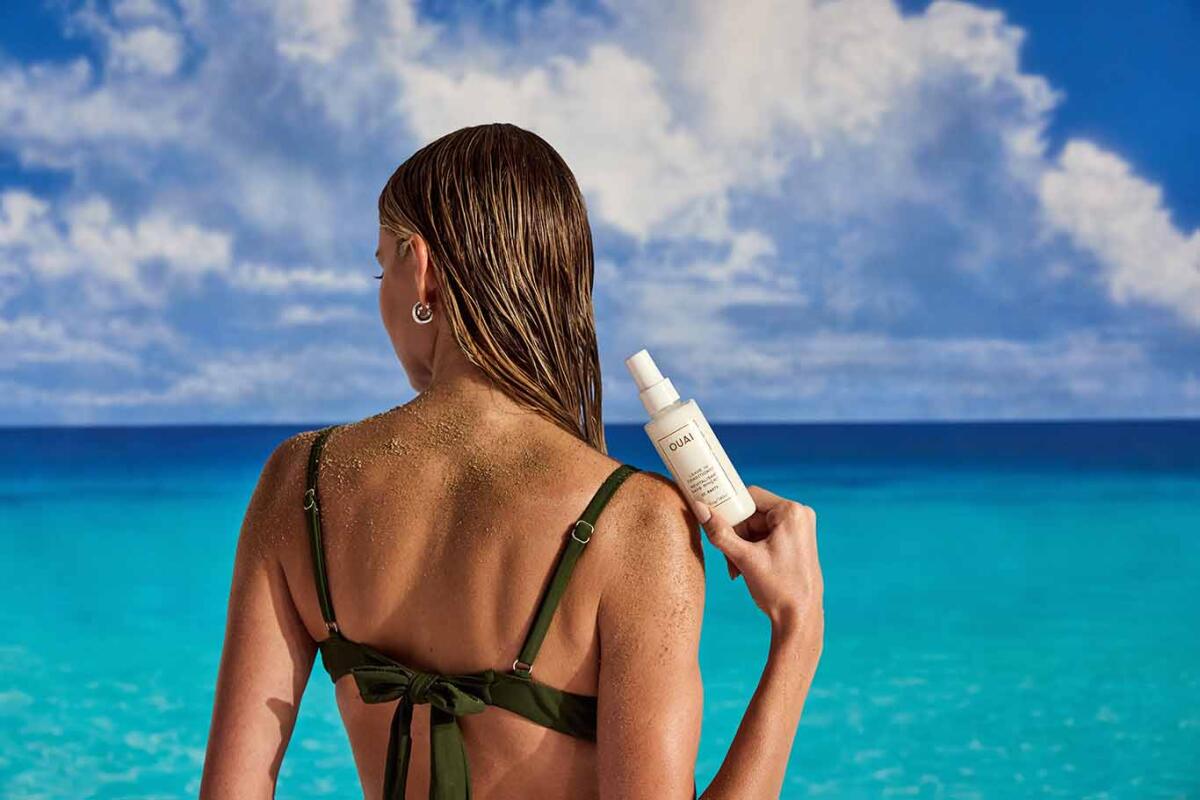Chlorine-Proof Hair Hacks Every Blonde Needs This Summer

Discover the best expert-backed strategies, products, and poolside rituals to shield blonde hair from chlorine damage this summer, before it turns green.
- Share via
LA Times Studios may earn commission from purchases made through our links.
Let’s start with the truth: chlorine doesn’t care about your $300 balayage. It doesn’t care how many hours you spent with foils in your hair, or that your colorist promised “buttery, sun-kissed blonde” and not “seaweed shimmer.” The moment you dip your head into a pool, chlorine begins its quiet campaign of destruction — oxidizing your strands, stripping away oils, and turning all that bright blonde effort into a dull, brittle afterthought.
So what’s the #1 mistake people with blonde hair make during summer? Simple: swimming without protection.
Pool water might feel refreshing, but it’s chemically harsh. “It will badly damage your hair and literally annihilate your color,” says Adam Livermore, a global artist with Oribe Hair Care. “Saltwater pools aren’t much better; they often contain chlorine or bromine, too.”
What Chlorine Actually Does to Hair (It’s Worse Than You Think)
When you jump into a chlorinated pool, you’re not just getting wet, you’re immersing your hair in a chemical bath designed to kill bacteria. That same chlorine disrupts the outer layer of your hair (the cuticle), leaches color molecules from strands, and opens the door for oxidation damage. Dermatologists explain that chlorine also breaks down the protein structure of hair, causing weakness, dryness, and frizz.
Even more shocking? The minerals in pool water, especially copper, can bind with chlorine to create compounds that stain blonde hair green.
And if you’re dealing with thinning hair or hair loss? Chlorine can be an accelerant. One study found that chlorine exposure may exacerbate existing scalp sensitivities and trigger follicle stress in some individuals.
How to Protect Blonde Hair from Chlorine in a Pool
Don’t panic. Prevention is possible. Your smartest defense? A swim cap. But if that feels a bit too Olympic for your vibe, Livermore suggests a simple, effective workaround: “Comb coconut oil through dry hair and twist it into a treatment bun before you get in, the oil helps block the water.”
In a pinch, even soaking your hair with tap water beforehand can help. “Think of your hair like a sponge,” he adds. “A wet sponge is a lot less absorbent than a dry one.”
Translation? Your blonde strands should never go into a pool “hungry.”
Here’s your pre-swim protocol:
- Soak your hair with clean tap water before swimming.
- Saturate with coconut oil or leave-in conditioner to create a hydrophobic barrier.
- Secure hair into a bun or braid, and tuck it under a silicone swim cap.
Does Coconut Oil Protect Hair from Pool Water?
Yes, and not just as a folklore remedy. Coconut oil’s molecular structure allows it to penetrate the hair shaft and seal in moisture. It works as a buffer, reducing water absorption and preventing chlorine from fully entering the cuticle. But it only works if applied before you swim, and in generous amounts.
Just don’t expect it to double as SPF for your scalp or color protection against UV damage. Pair it with a UV-protective spray if you’re sunbathing post-swim.
The Best Products for Chlorine-Damaged Hair
If you didn’t prep, and your hair is now straw-like, color-faded, or worse (green-tinged), you need to start the rehab process, stat.
Here’s what the pros recommend:
- Chelating shampoos like Ouai’s Detox Shampoo help remove chlorine and mineral buildup.
- Protein-rich masks (try amika’s the kure) rebuild internal bonds.
- Color-safe shampoos and conditioners replenish lost moisture.
- Purple-toning products neutralize brassiness and green undertones.
Avoid clarifying shampoos unless they’re sulfate-free. They may strip the remaining color and further dry out the cuticle.
Hydration and Hair Breakage: Why Your Water Intake Matters
Here’s what most pool-season guides forget: hydration isn’t just topical. Hair is made of keratin, but it thrives on water.
Dehydration leads to brittle, breakage-prone hair that’s more vulnerable to chemical damage as proper internal hydration helps maintain scalp health and elasticity of hair strands.
In summer, drink more than the standard 8 cups per day. Especially if you’re also following a low-carb diet or exercising regularly, both of which increase fluid loss.
Leave-In Conditioners for Summer (and How to Use)
You want something lightweight, UV-protective, and moisture-sealing, without weighing your hair down.
Stylists often recommend:
- Oribe Supershine Moisturizing Cream, $54
- OUAI’s Leave-In Conditioner, $30
- Milk_Shake Leave-In Conditioner, $26
Apply it from mid-lengths to ends on damp hair before you leave the house. Reapply after swimming or sun exposure.
Leave-ins are especially important for beach days, as ocean salt can be equally drying.
How to Reverse Chlorine Damage (If It’s Too Late)
You didn’t wear a cap. You forgot the coconut oil. You didn’t rinse right away. Now what?
Step 1: Rinse with filtered water ASAP.
Step 2: Use a chelating shampoo to strip chlorine and metal buildup.
Step 3: Deep condition like it’s your job. Once weekly, use a hydrating hair mask with ingredients like panthenol, keratin, or aloe.
Step 4: Book a gloss or toner treatment if your color is oxidized or off-toned. Your colorist can cancel out brass or green tones.
Step 5: Avoid hot tools while your hair is recovering. Air-dry with a microfiber towel and detangle with a wide-tooth comb.
And next time? Don’t skip the prep. Chlorine is relentless, but your hair game can be smarter.
Final Takeaway: Blonde and Brilliant, Even After a Pool Party
You shouldn’t have to choose between cool summer dips and cool-toned blonde. With a little foresight (a swim cap, a coconut oil bun, or the right post-swim repair lineup), you can protect your investment and keep your hair healthy, hydrated, and summer-proof.
Click here to learn more about Oribe











